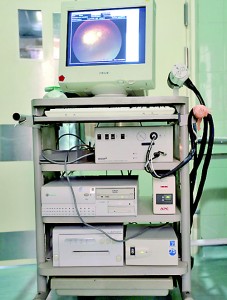News
Eye doctor’s act which went beyond the call of duty
He dis-assembled the machine weighing 60kg, went to the 1-£ (Pound) Shop in England, bought a bundle of bubble-wrap and wrapped the machine parts well. The next layer of ‘wrapping’ was with his thick and heavy winter-clothing, which he would not need as he was coming back to Sri Lanka.

Dr. Hiranya Abeysekera
Then it was time to ship the machine, for which he paid £200 out of his pocket and kept his fingers crossed that the machine would be intact when it arrived back home.
He flew back to Sri Lanka in February and the machine arrived a month later in March.
Now the Retcam, the only one in the country, is in the operating theatre of the Eye Unit of the Lady Ridgeway Hospital (LRH) for Children in Colombo. It is a major asset in the diagnosis and treatment of little ones with Retinoblastoma and is at the LRH because one doctor went beyond the call of duty.
It is 39-year-old Dr. Hiranya Abeysekera’s fascination with the human eye and his passion to treat children with this serious condition that made him bring the Retcam without thinking that the lack of this equipment in Sri Lanka is none of his business.
Not only did he return to the country after acquiring knowledge and expertise through his foreign training, but he also brought back this invaluable Retcam, says Consultant Ophthalmologist Dr. Dharma Irugalbandara who heads the LRH Eye Unit where hundreds of children are treated daily.
Sometimes post-graduate doctors who go abroad for training decide to stay on in those countries, the Sunday Times learns.
For Dr. Hiranya there was never a doubt that he would come back to serve the children of this country. From Balapitiya, Dr. Hiranya who had his primary education at Hagalla Maha Vidyalaya, Kosgoda, where his mother too was a teacher, it was to Royal College, Colombo that he came after his success at the Grade 5 scholarship examination. From there he entered the Sri Jayawardhanapura University’s Medical Faculty.
Even as a medical student, he was intrigued by the eye, which he calls “special”.
It is a small organ but it has many, many types of tissue which make up its different layers and integrate to give us vision, he says. “Ophthalmology also drew me because it is an advanced subject linked to technology that changes fast in diagnosis and treatment.”
It is a fast-developing subject and not stagnant, says Dr. Hiranya who interned at the Colombo South Teaching Hospital in Kalubowila coming under the influence of Consultant Paediatrician Dr. Kalyani Guruge and had his first post-intern appointment at the Anuradhapura Teaching Hospital. At the Neonatology Unit there, he realised his potential to work with children, under the guidance of Consultant Neonatologist Dr. Pushpa Kumar.
While working in Anuradhapura, he passed Module 1 of Ophthalmology at the Post-Graduate Institute of Medicine (PGIM). Next he had intensive training at the National Eye Hospital, while passing the other four modules of Ophthalmology and gaining his MD in 2010.
Thereafter, to the Birmingham Children’s Hospital in England considered “one of the best and largest paediatric hospitals in Europe” that Dr. Hiranya proceeded for his foreign training, which is a requirement to become a Specialist. He was on a Fellowship in Paediatric Ophthalmology. “I was lucky to work there,” he says with humility.
Retinoblastoma, a rare cancer which can affect the eyes of children, he studied under veterans John Ainsworth and Manoj Parulekar while training to become a fully-fledged Paediatric Ophthalmologist.
Seeing his devotion to its study and the potential to develop Paediatric Ophthalmology in Sri Lanka and also being sure that Dr. Hiranya would return to Sri Lanka, the doctors at Birmingham had offered the Retcam they were using there, when the hospital bought a new one.
“Something is better than nothing,” says Dr. Hiranya. A new one costs £90,000.
The Retcam has been in operation for three weeks now with about 12 children having their eyes imaged.
As we leave the LRH Eye Unit what comes to mind are the words of a former President of the United States America, John F. Kennedy, which have been proven by Dr. Hiranya in his own way: “Ask not what your country can do for you, ask what you can do for your country.”
| Benefits of Retcam
The Retcam helps improve the management of Retinoblastoma as it is capable of taking photographs inside the eye of an anaesthetised child, explains Dr. Hiranya Abeysekera. With the universal prevalence of Retinoblastoma being 1 in 20,000 live births, “it is a potentially sight-threatening and life-threatening condition”, he says, stressing that early diagnosis is crucial.  Pix by M.A. Pushpa Kumara In Sri Lanka, with around 360,000 annual live births, the prevalence of Retinoblastoma may be estimated between 15-20 children per year. The photographs taken by the Retcam would not only aid the correct diagnosis of Retinoblastoma but also help Oncologists and Retinal Surgeons treating affected children to discuss treatment options with colleagues by sharing these images. They could also be shared with world experts for their opinion, it is learnt. Now these pictures can be e-mailed, while earlier the patient would have to be sent to the other doctors. The Retcam would also prevent the child from being anaesthetised repeatedly when different doctors treating them have to look into their eyes. An early sign of Retinoblastoma which presents from birth to about 3-4 years or in “young” children could be a squint, according to Dr. Hiranya. Another early sign of Retinoblastoma could be a red eye when the child is photographed with a digital camera, according to him. |


